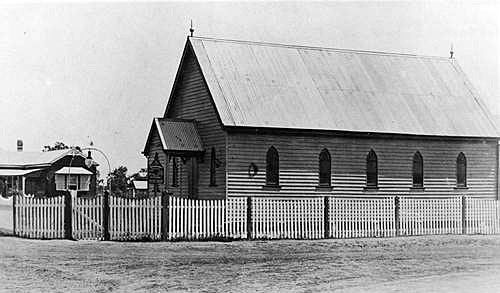
The Methodist Church, Oakey, c.1912
[Photograph: John Oxley Library, State Library of Queensland]
Historical and Technical Documentation by Geoffrey Cox
© OHTA 2012, 2014 (last updated October 2014)
Mr. W.J. Snow, a jeweller of Toowoomba, and one-time organist of the Neil-street Methodist Church there, is reported to have built an organ for his residence at the corner of Margaret and Lindsay Streets, Toowoomba, around 1920.1 Snow was the uncle of Charles S. Snow, who had built an organ for his residence 'Leckhampton', Kangaroo Point some years earlier. There is certainly a record of various parts for an organ being sent to W.J. Snow of Toowoomba by Whitehouse Bros in 1922.2
It appears most likely, however, that the organ Snow installed at the time was not built by him, for a letter written by Snow in 1921 reveals that the organ had been kept in storage in Melbourne from around 1914.3 Assuming that this was the instrument Snow installed, the original builder is not know. Snow's organ was removed in 1926 to the Methodist Church, Oakey, where it was dedicated on 28 February by the Rev. Dr Bowe of Brisbane.4

The Methodist Church, Oakey, c.1912
[Photograph: John Oxley Library, State Library of Queensland]
Following neglect and disuse, the organ was acquired by H.W. Jarrott around 1955 and installed in his mother's house at 15 Simpson Street, Morningside. The specification of the instrument, as it had existed at Oakey (and presumably also at Toowoomba), was as follows:
| MANUAL Open Diapason Keraulophon Hohl Flute Principal PEDAL Bourdon |
8 8 8 4 16 |
No couplers
Mechanical action
Compass: 54/20 (down to F only on both manual and pedals).5
Jarrott installed the organ at Morningside without major alteration, except that a new 30-note pedalboard was added, using tubular-pneumatic action. No new pedal pipes were added. The instrument was broken up around 1959. The Bourdon 16ft stop went to Christ Church Anglican Cathedral, Grafton, NSW, and the blower to the Baptist Church, Brighton. The Keraulophon went to the Baptist Church, South Brisbane. The remainder of the instrument was discarded.6
_______________________________________________________________________
1 Personal communication to G. Cox from Walter Emerson, February 1974.
2 Whitehouse Bros Ledger (1922-1940), p. 109.
3 Letter from W. J. Snow to George Fincham & Sons, June 1921, cited by Graeme Rushworth.
4 Personal communication to G. Cox from Walter Emerson, February 1974; The Queenslander (3 April 1926), p. 40.
5 Specification supplied in personal communications to G. Cox from H.W. Jarrott, February 1974 and January 2006; also given in The Queenslander (3 April 1926), p. 40, where the Hohl flute 8ft is given as 'wald flute 8ft'.
6 Personal communications to G. Cox from H.W. Jarrott, February 1974 and January 2006.